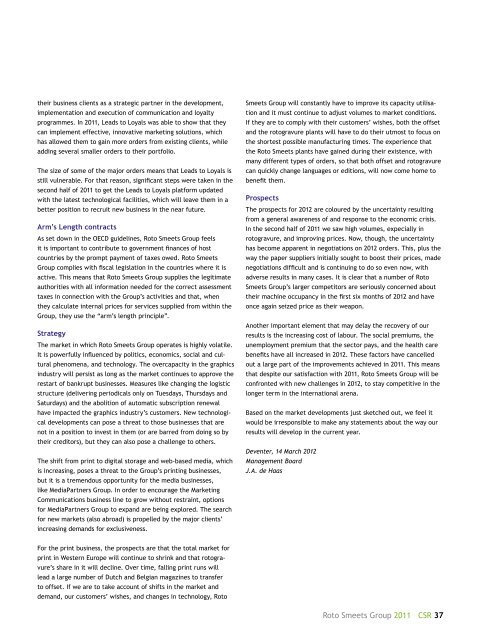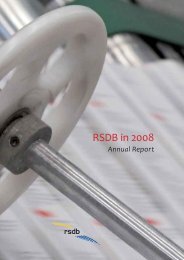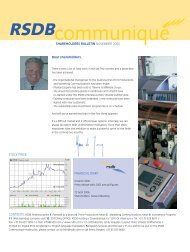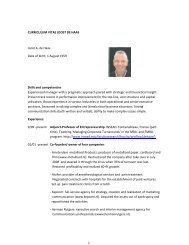Corporate Social Responsibility Report 2011 - Roto Smeets Group
Corporate Social Responsibility Report 2011 - Roto Smeets Group
Corporate Social Responsibility Report 2011 - Roto Smeets Group
You also want an ePaper? Increase the reach of your titles
YUMPU automatically turns print PDFs into web optimized ePapers that Google loves.
their business clients as a strategic partner in the development,implementation and execution of communication and loyaltyprogrammes. In <strong>2011</strong>, Leads to Loyals was able to show that theycan implement effective, innovative marketing solutions, whichhas allowed them to gain more orders from existing clients, whileadding several smaller orders to their portfolio.The size of some of the major orders means that Leads to Loyals isstill vulnerable. For that reason, significant steps were taken in thesecond half of <strong>2011</strong> to get the Leads to Loyals platform updatedwith the latest technological facilities, which will leave them in abetter position to recruit new business in the near future.Arm’s Length contractsAs set down in the OECD guidelines, <strong>Roto</strong> <strong>Smeets</strong> <strong>Group</strong> feelsit is important to contribute to government finances of hostcountries by the prompt payment of taxes owed. <strong>Roto</strong> <strong>Smeets</strong><strong>Group</strong> complies with fiscal legislation in the countries where it isactive. This means that <strong>Roto</strong> <strong>Smeets</strong> <strong>Group</strong> supplies the legitimateauthorities with all information needed for the correct assessmenttaxes in connection with the <strong>Group</strong>’s activities and that, whenthey calculate internal prices for services supplied from within the<strong>Group</strong>, they use the “arm’s length principle”.StrategyThe market in which <strong>Roto</strong> <strong>Smeets</strong> <strong>Group</strong> operates is highly volatile.It is powerfully influenced by politics, economics, social and culturalphenomena, and technology. The overcapacity in the graphicsindustry will persist as long as the market continues to approve therestart of bankrupt businesses. Measures like changing the logisticstructure (delivering periodicals only on Tuesdays, Thursdays andSaturdays) and the abolition of automatic subscription renewalhave impacted the graphics industry’s customers. New technologicaldevelopments can pose a threat to those businesses that arenot in a position to invest in them (or are barred from doing so bytheir creditors), but they can also pose a challenge to others.The shift from print to digital storage and web-based media, whichis increasing, poses a threat to the <strong>Group</strong>’s printing businesses,but it is a tremendous opportunity for the media businesses,like MediaPartners <strong>Group</strong>. In order to encourage the MarketingCommunications business line to grow without restraint, optionsfor MediaPartners <strong>Group</strong> to expand are being explored. The searchfor new markets (also abroad) is propelled by the major clients’increasing demands for exclusiveness.<strong>Smeets</strong> <strong>Group</strong> will constantly have to improve its capacity utilisationand it must continue to adjust volumes to market conditions.If they are to comply with their customers’ wishes, both the offsetand the rotogravure plants will have to do their utmost to focus onthe shortest possible manufacturing times. The experience thatthe <strong>Roto</strong> <strong>Smeets</strong> plants have gained during their existence, withmany different types of orders, so that both offset and rotogravurecan quickly change languages or editions, will now come home tobenefit them.ProspectsThe prospects for 2012 are coloured by the uncertainty resultingfrom a general awareness of and response to the economic crisis.In the second half of <strong>2011</strong> we saw high volumes, expecially inrotogravure, and improving prices. Now, though, the uncertaintyhas become apparent in negotiations on 2012 orders. This, plus theway the paper suppliers initially sought to boost their prices, madenegotiations difficult and is continuing to do so even now, withadverse results in many cases. It is clear that a number of <strong>Roto</strong><strong>Smeets</strong> <strong>Group</strong>’s larger competitors are seriously concerned abouttheir machine occupancy in the first six months of 2012 and haveonce again seized price as their weapon.Another important element that may delay the recovery of ourresults is the increasing cost of labour. The social premiums, theunemployment premium that the sector pays, and the health carebenefits have all increased in 2012. These factors have cancelledout a large part of the improvements achieved in <strong>2011</strong>. This meansthat despite our satisfaction with <strong>2011</strong>, <strong>Roto</strong> <strong>Smeets</strong> <strong>Group</strong> will beconfronted with new challenges in 2012, to stay competitive in thelonger term in the international arena.Based on the market developments just sketched out, we feel itwould be irresponsible to make any statements about the way ourresults will develop in the current year.Deventer, 14 March 2012Management BoardJ.A. de HaasFor the print business, the prospects are that the total market forprint in Western Europe will continue to shrink and that rotogravure’sshare in it will decline. Over time, falling print runs willlead a large number of Dutch and Belgian magazines to transferto offset. If we are to take account of shifts in the market anddemand, our customers’ wishes, and changes in technology, <strong>Roto</strong><strong>Roto</strong> <strong>Smeets</strong> <strong>Group</strong> <strong>2011</strong> CSR 37






